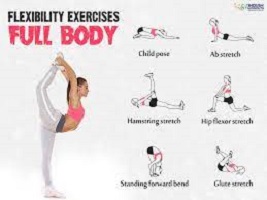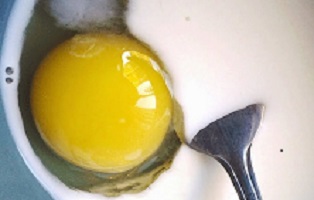Flexibility Exercises ~ 14 Exercises to Improve Your Flexibility
Flexibility Exercises Meaning~ 14 Exercises to Improve Your Flexibility at Home

A proper stretching routine is necessary to avoid injuries during the sporting season. An important aspect of injury prevention is flexibility.
Stretching before exercise helps the muscles get ready for exercise. It has been established that stretching after exercise is even more crucial for avoiding injury.
Everyone needs exercise with flexibility; gymnasts are not the only ones who need it. In addition to improving range of motion, it lowers the chance of injuries, improves blood flow and nutrient delivery to joints, eases muscular tension, and other benefits.
These flexibility exercises can be performed at home to help with mobility and health improvement.
If you haven’t exercised much recently, don’t panic; the exercises are light and simple to complete
Carry water and wear loose, comfortable clothing. Build up slowly and aim to gradually increase the repetitions of each exercise over time.
At least twice a week, try to perform these exercises at home using the flexibility exercise app.. Stretching after a training program relaxes tense muscles, making it an essential component of a regular exercise practice.
Directions on Flexibility Exercises for Seniors
Before performing any of these stretches, be careful to warm up. Warm-up exercises include walking quickly for a while or slowly sprinting in place.
Carefully complete the activities; speed is unimportant. By no means bounce a stretch. Muscle strains and other ailments can result from bouncing.
If you have an injury, talk to a physical therapist or athletic trainer about the best flexibility program because stretching could make it worse.
With these 10 easy flexible exercises, you may increase the flexibility of certain muscles as well as your entire body:
- Standing quad stretch
Put your feet together as you stand. Lift one foot behind you, grasp it firmly in both hands, and yank the heel in the direction of your buttock. For roughly five seconds, hold. Put the other foot down and repeat.
- Standing side stretch
Lift your arms high while standing with your feet shoulder-width apart. Put your hands together in a fist-clout.
Reach upward as you inhale, and as you exhale, bend your upper body to the right. Take a five-second hold. Exhale, go back to the beginning, then repeat on the left side
- Seated Hamstring Stretch
Sit on the floor and extend your right leg in the front. Bend your left leg with the sole placed against your inner thigh.
Leaning forward, pull the toe of your ankle as close to your body as you can, then, switch to the other leg and hold for another 10 seconds.
- Standing Calf Stretch
Place your palms flat and shoulder-width apart on the wall while you stand about three feet away from it. With the toes pointed forward, place the right foot behind you.
Lean forward while keeping your right knee straight and your heel firmly planted. Hold for a little while, then switch to the other leg.
- Shoulder Stretch
With the other hand, grip one elbow and draw it across your chest while standing straight. Hold for a little while, then repeat on the opposite side.
- The Forward Hang
Stand with your knees slightly bent and your feet hip-width apart. Put your fingers together behind your back.
Take a breath and raise your arms. Exhaling, bend at the waist and raise your hands toward your head. Take a five-second hold.
- Backstretch
Get down on all fours, knees, and hands by your sides. Curl your back up toward the ceiling as you inhale.
Hold the position for a short while before going back to the beginning position. Hold for a few seconds while you dip your back and push your tummy toward the floor.
- Butterfly Groin Stretch
Put your feet together and bring them toward your groin while sitting up straight on the floor.
Grab your feet, bend your knees to the sides, and softly press down until you feel a stretch in your inner thighs and groin.
Then, turn your chest to the right.
- Split Squat
Put your feet hip-width apart and stand. The front with your right foot. Interlace your fingers while keeping your hands under your ribs.
Squeeze your glutes, contract your pelvic floor muscles, and tuck your pelvis in. Slowly bending both knees, you should descend to the count of three.
Come back up to the count of three while pressing into the floor. Repeat while changing legs.
- Modified Cobra
Thumbs directly beneath the shoulders, feet outstretched while you supinely lay on the ground on your stomach.
Effortlessly tuck the pelvis in while tightening the pelvic floor and glutes.
Push through the thumb and index finger to raise your chest. Hold for five seconds before going back to where you were.
You may do these flexibility exercises at home.
Try to perform the following exercises two or more times per week, along with the other routines in this series:
Neck rotation
Increases flexibility and mobility of the neck.
- Maintain an upright, relaxed posture. Look directly forward
- As far as it’s comfortable, swivel your head slowly in the direction of your left shoulder. Return to the starting position after holding for five seconds
- Continue to the right.
Do 3 rotations on each side.
Neck stretch
Good for loosening tight neck muscles.
- Hold your left shoulder down with your right hand while sitting up straight.
- Holding your shoulder down, slowly incline your head to the right.
- Repeat on the opposite side.
Hold each stretch for 5 seconds and repeat 3 times on each side.
Sideways bend
Helps the lower back regain flexibility
- Place your arms at your sides and stand tall with your feet hip-width apart.
- As far as is comfortable, slide your left arm down your side. You should feel a stretch on the opposing hip as you drop your arm.
- Repeat with your right arm.
Hold each stretch for 2 seconds and perform 3 on each side.
Calf stretch
Excellent for releasing tense calf muscles
- For stability, lean your hands against a wall. Step back at least a foot with the left leg while bending the right leg while keeping the left leg straight. The flat ground should be reached with both feet.
- By keeping the left leg as straight as possible and the left heel on the floor, the left calf muscle is stretched.
- Repetition with the other leg.
Stretches to Help You Get Loose
- · Side Lunge Stretch
- · Calf Stretch
- · Chest and Shoulder Stretch
- · Glute Bridge
- · Standing Quad Stretch
- · Cobra
- · Standing Hip Flexor Stretch
- · Butterfly Stretch
- · Standing Hamstring Stretch
- · Sideways Neck Stretch
- · Lying Knee-to-Chest Stretch
People also ask about Flexibility Exercises
What are 7 exercises with flexibility? 7 simple stretches to become more flexible
- Ways to Improve your flexibility
- Standing Hamstring Stretch
- Piriformis Stretch
- Triceps Stretch
- Butterfly Stretch
- Seated Shoulder Squeeze
- Side Bend Stretch
- Knee to Chest Stretch
What are 8 exercises for flexibility? 8 Exercises to Improve Your Flexibility for Dancers
- Standing Quad Stretch. Stand with your feet together
- Standing Side Stretch. Standing with your feet together, lift your arms overhead.
- Seated Hamstring Stretch
- Standing Calf Stretch
- Shoulder Stretch
- The Forward Hang
- Backstretch
- Butterfly Groin Stretch
What are 3 types of flexibility exercises?
When it comes to stretching, there are three main techniques:
- Static
- Dynamic
- Ballistic stretching.
What is the best flexibility exercise? 5 Best Workouts to Make You More Flexible
- Take a yoga class. Yoga reduces stress and allows you to focus by using breath control, simple meditation, and bodily postures
- Go for dynamic stretching over static stretching
- Try tai chi
- Add stretch-bands to your routine
- Follow up with foam rollers
What are 5 exercises for flexibility?
If you have an injury, talk to a physical therapist or athletic trainer about the best flexibility program because stretching could make it worse.
Forward Lunges
- Side Lunges
- Cross-Over
- Standing Quad Stretch
- Seat Straddle Lotus
- Seat Side Straddle
- Seat Stretch
- Knees to Chest
What are 5 examples of flexibility? 5 Examples of Flexibility Exercises are
- Bend and Twist. Stand with your arms crossed, hands on opposite shoulders, knees bent slightly, and feet shoulder-width apart
- Lower Leg Stretch. Stand facing a wall with your feet about shoulder-width apart
- Standing Hip Bend
- Achilles Tendon Stretch
- Sitting Stretch
What are 3 dynamic stretches?
Dynamic stretches can be a succession of movements to get the body moving before any type of exercise.
Some examples include walking lunges, trunk twists, or leg swings against a wall.
Is yoga a flexibility exercise?
Flexibility: Yes.
Yoga poses stretch muscles and increases the range of motion. With steady practice, they’ll improve your flexibility.
Is there flexibility in sit and reach?
One of the linear flexibility tests that helps determine how extensible the hamstrings and lower back are is the “sit and reach” test.
What are the 4 types of flexibility?
Static, ballistic, PNF, and dynamic stretching are the four main techniques used to increase flexibility
What are 2 types of flexibility exercises?
There are two forms of flexibility exercises: dynamic stretching, which combines stretching with movements, and static stretching, which involves stretching a muscle while not moving.
What are the 4 types of stretches? 4 Different Stretching exercises for Different Situations
- Active Stretching. Active stretching involves holding a pose to utilize a targeted muscle group
- Passive Stretching. This type of stretching is best for balance enhancement and flexibility.
- Dynamic Stretching
- PNF Stretching
Give examples of each of the three types of flexibility ~ exercises to improve flexibility
Three basic categories of stretching techniques are thought to increase muscle flexibility. These are:
- Static stretching
- Dynamic stretching
- Proprioceptive neuromuscular facilitation (PNF).
Define flexibility and provide Flexibility Exercises examples.
The ability to adapt, bend, or convince is known as flexibility. Being able to work whenever one wishes is an example of the flexibility
What is an example of a flexibility exercise?
A flexible person or object is one who or something that can be easily bent, convinced, or transformed.
A yoga pro is an illustration of flexibility. A work schedule that enables work to be done at any time of the day is an illustration of flexibility.
pliable; capable of being bent or flexed.
What are the 8 dynamic stretches? These 8 simple exercises work as a dynamic warm-up for kids of any age or sport.
Repeat as necessary.
- Jumping Jacks
- Walking Knee Hugs
- Arm Circles
- Side Shuffles.
- Backpedaling.
- Leg Swings
- Lunges
- Squats
What are 7 dynamic stretches? Seven Dynamic Stretching Exercises
- Reverse lunge with a twist. Take an exaggerated step backward with the right leg
- Knee cradle. Standing, lift your left leg with the knee facing outwards
- Straight leg march
- Buttock kicks
- High knees
- Carioca
- Scorpion
What are the 7 warm-ups? The Simple 7 Warm-Up
- Hip Flexor Stretch. Stretching the hip flexors (the front or anterior hips) will help you move better in general
- Glute Bridge (One-Legged or Two)
- Hip Abduction
- Extension and Rotation of The Thoracic Spine
- The Floor Slide
- The Shoulder Press Push-Up
- Squat to Stand
Is Pilates a flexibility exercise?
Pilates is a type of exercise akin to yoga that focuses on core strength, posture, balance, and flexibility through a series of movements.
Is Pilates good for flexibility?
All of the body’s major muscle groups are evenly stretched and lengthened by Pilates. Flexibility, strength, balance, and body awareness all get better.
What yoga is best for flexibility?
What are the Best Yoga Poses for Flexibility?
- Reclined Hand to Big Toe Pose (Supta Padangusthasana) …
- Eye of the Needle Pose (Sucirandhrasana) …
- Downward Facing Dog (Adho Mukha Svanasana) …
- Crescent Lunge (Anjaneyasana) …
- Pyramid Pose (Parsvottanasana) …
- Half Moon Pose (Ardha Chandrasana) …
- Garland Pose (Malasana)
How can I test my flexibility at home?
Reach behind your head with your right elbow bent so that your palm touches your torso.
Your fingers should be pointing downward as you extend as far as you can along the middle of your back.
With your palm facing outside and your fingers up, place your left arm behind your back. Try to touch your other hand by extending your reach as high as you can.
What is the zipper test?
Shoulder flexibility test (zipper test)
This examination gauges the range of motion and flexibility in your shoulder and upper arm joints.
Place one hand along the spine and behind the neck. then raise your opposing hand toward your top hand from behind your back.
How many pushups are good?
A lot of folks perform over 300 pushups each day.
However, if done correctly, even 50 to 100 push-ups should be sufficient for the average individual to retain a strong upper body.
Start with 20 pushups, but don’t limit yourself to that number.
It’s crucial to continue raising the amount to keep your body guessing
What are the 6 types of flexibility training programs? flexibility exercises for beginners
A flexibility training program can be made up of different types of stretching:
- Dynamic stretching.
- Ballistic stretching.
- Static Passive stretching.
- Isometric stretching.
- Static Active stretching.
- PNF stretching.
What are the different types of flexibility training?
The different types of stretching are:
- Ballistic stretching.
- Passive (or relaxed) stretching.
- Static stretching.
- Isometric stretching.
- Dynamic stretching.
- Active stretching.
- PNF stretching.
What is the difference between stretching and flexibility?
Stretching, which is described as “the ability to passively accomplish wide ranges of motion,” is a training technique used to increase flexibility.
There are numerous stretching methods, with static and dynamic stretching being the most well-known.
What is physical flexibility?
Flexibility is the capacity of a joint or group of joints to move freely and without experiencing any pain.
Although everyone’s ranges of flexibility differ significantly, they must be met in order to preserve the health of joints and the entire body.
Are stretching and yoga the same thing?
Stretching and yoga are two completely different disciplines, despite having a similar appearance and feel.
The sole goal of stretching exercises is to improve flexibility.
Although holding static stretches is a part of yoga, it is merely one aspect of the practice.
What are flexibility skills?
The Thinking Skill of flexibility focuses on a child’s capacity to adjust to novel circumstances, innovate, and change approaches to deal with various obstacles.
Why are flexibility exercises essential?
Physical fitness requires flexibility, which provides numerous health benefits for the body.
For example, it enhances muscle coordination, posture, mobility, and risk of injury and pain. Even greater overall “shape” results from it.
What are 5 warm up exercises?
Leg bends, leg swings, shoulder/arm circles, jumping jacks, jumping rope, lunges, squats, walking or a slow jog, yoga, torso twists, standing side bends, lateral shuffles, butt kickers, knee bends, and ankle circles are a few further examples of warm-up exercises.
What is flexibility warm up?
Warm-up with exercises that incorporate stretching and controlled movements to improve your dynamic flexibility.
The motions should resemble the action you are about to perform. For instance, you should warm up with leg circles to simulate kicking before playing soccer.


